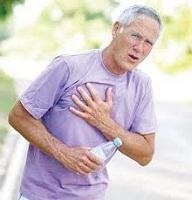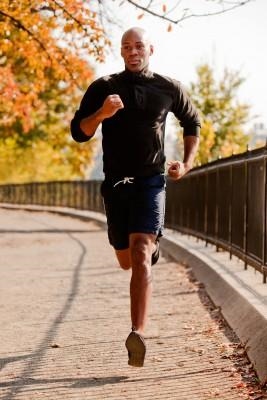Abstract
For most people, mouth breathing during physical exercise reduces alveolar and arterial CO2 levels and prevents absorption of nasal nitric oxide produced in sinal cavities. Since CO2 is a powerful bronchodilator and vasodilator, mouth breathing causes bronchospasm and reduces oxygen transport to body cells. Nose breathing during exercise prevents most episodes of sport induced asthma.
Hyperventilation is normal in people with asthma
Hyperventilation or ineffective breathing is a norm among patients with asthma (except just before the death that is characterized by agonal breathing). These Table shows the results of 5 medical studies that measured minute ventilation in people with asthma.
Chronic hyperventilation (or breathing more than the tiny medical norm) reduces alveolar and end-tidal CO2. Carbon dioxide is a potent bronchodilator. As a result, overbreathing leads to hypocapnic bronchospasm (bronchoconstiction). This effect is present at rest. It leads to low level of oxygen in body cells and suppresses the immune system.
Bear in mind that healthy people have higher arterial CO2 values and more O2 in body cells due to their slow and light abdominal breathing. Normal pulmonary ventilation values (for healthy people) are only about 6-7 liters per minute, and similar values are provided in most medical and physiological textbooks.
Effects of exercise with mouth breathing
Mouth breathing during exercise further reduces CO2 levels in airways and worsens bronchospasm. In addition, large ventilation rates lead to cooling and drying of airways worsening existing inflammation. All these factors directly contributes to classical symptoms of asthma and acute asthma exacerbations:
* Bronchospasm (narrowing of airways: bronchi and bronchioles) – caused by CO2 deficiency
* Increased inflammation of airways (caused by cell hypoxia produced by hyperventilation, see CO2: Inflammatory Response)
* Excessive production of sputum in airways
* Reduced utilization of NO (nitric oxide) that is produced in sinuses leading to more respiratory infections and constriction of blood vessels due to the vasodilating effects of NO.
Indeed, in 2 published medical studies, Western medical doctors compared effects of nose breathing vs. mouth breathing during exercise in people with exercise induced asthma and normal subjects. Both studies that nasal breathing provides more benefits, including better conductance of airways, improved results of lung function tests and some others. The abstracts of these studies are attached at the bottom of this knol.
Effects of exercise with nasal respiration (in and out)
Nose breathing only helps to warm and humidify the incoming air. It also leads to increased CO2 in the lungs helping repair of the lung tissue. Higher alveolar CO2 improve gas exchange and increase oxygen availability for body cells. Hence, the key effects are:
* Bronchodilation – caused by increased CO2 pressure
* Gradually reduced inflammation of airways – caused by higher body O2 levels
* Normal production of mucus in airways
* Normal utilization of nasal NO (nitric oxide) to eliminate pathogens in the lungs and dilate blood vessels.
Can an asthmatic exercise with nose breathing?
Most asthmatics cannot do intensive exercise (like running) with nose breathing only because their breathing is too heavy at rest. As a result, they would breathe much more air during exercise.
However, as a first step, they can and should do only light exercise until they increase their low body oxygen levels up to 20 seconds. Exercise with nose breathing is safe and very effective. Hundreds of Russian doctors (who teach the Buteyko breathing technique, Frolov respiratory device therapy, and other methods) recommend nasal respiration during exercise to all patients with asthma. Particularly, it has a profound positive effect on quality of sleep, especially if these asthmatics prevent supine sleep and tape their mouth at night to prevent acute hyperventilation during early morning hours. (Bear in mind that, apart fro, exercise induced asthma, early morning hours have highest rates of asthma attacks due to the “sleep heavy breathing effect”. )
With over 20 s for the body oxygen test, they can resume running with nose breathing only. At this body oxygen levels, people with asthma does not have symptoms and signs and do not require medication. It may take some weeks before an average asthmatic gets to this level by slowing down his or her breathing pattern at rest.
Many hours of physical exercise can achieve this effect, but the fastest way is to use the Oxygen Remedy therapy. There are online Oxygen Remedy breathing classes based on the use of the Frolov respiratory device and Buteyko method lifestyle program. This is the fastest and easiest technique to increase body oxygen levels. Among the most effective breathing devices for asthma are the Amazing DIY Breathing Device, Frolov device, Samozdrav and some others.
Resources from NormalBreathing.com
Effects of breathing exercises on asthma symptoms – How breathing retraining reduces and eventually eliminates symptoms and signs of asthma and its medication
Exercise-Induced Asthma: Its Definition, Causes and Treatment
Mouth Taping medical technique to prevent mouth breathing during sleep
Exertional Headache after Exercise Caused by Mouth Breathing (due to low O2 and CO2 in the brain)
Additional links
Mouth Breathing Is the Cause of Exercise Induced Asthma – An article by Dr. Artour Rakhimov from WorldWideHealth.com
Russian Doctors Treat Exercise-Induced Asthma with Nose Breathing – from Blogz.com
Medical Research Suggests Numerous Benefits of Nose Breathing for Exercise-Induced Asthma – from SelfGrowth.com
References for the Table
Chalupa DC, Morrow PE, Oberdörster G, Utell MJ, Frampton MW, Ultrafine particle deposition in subjects with asthma, Environmental Health Perspectives 2004 Jun; 112(8): p.879-882.
Johnson BD, Scanlon PD, Beck KC, Regulation of ventilatory capacity during exercise in asthmatics, J Appl Physiol. 1995 Sep; 79(3): p. 892-901.
Bowler SD, Green A, Mitchell CA, Buteyko breathing techniques in asthma: a blinded randomized controlled trial, Med J of Australia 1998; 169: p. 575-578.
Kassabian J, Miller KD, Lavietes MH, Respiratory center output and ventilatory timing in patients with acute airway (asthma) and alveolar (pneumonia) disease, Chest 1982 May; 81(5): p.536-543.
McFadden ER & Lyons HA, Arterial-blood gases in asthma, The New Engl J of Med 1968 May 9, 278 (19): 1027-1032.
Main references (medical studies)
Shturman-Ellstein R, Zeballos RJ, Buckley JM, Souhrada JF, The beneficial effect of nasal breathing on exercise-induced bronchoconstriction, Am Rev Respir Dis. 1978 Jul; 118(1): 65-73.
In the first step of a study of the relation of nasal and oral breathing during moderate treadmill exercise to the onset of bronchoconstriction in young patients with perennial bronchial asthma, it was observed that most subjects spontaneously breathed with their mouths open when instructed to breathe “naturally.” Subsequently, when they were required to breathe only through the nose during the exercise, an almost complete inhibition of the postexercise bronchoconstrictive airway response was demonstrated. When instructed to breathe only through the mouth during exercise, an increased bronchoconstrictive airway response occurred, as measured by spirometry, flow-volume relationships, and body plethysmography. These findings suggest that the nasopharynx and the oropharynx play important roles in the phenomenon of exercise-induced bronchoconstriction.
Mangla PK, Menon MP, Effect of nasal and oral breathing on exercise-induced asthma, Clin Allergy. 1981 Sep; 11(5): 433-9.
The effect of nasal as well as oral breathing during level-ground running for 6 min on the post exercise bronchial response was studied in fifteen people (five asthmatics with exercise liability, five asthmatics with no such liability and five normals). Each patient did the exercise twice; once with the nose clipped and once with the mouth closed. FEV1 was measured before exercise, immediately after exercise and at 5, 10, 15, 20 and 30 min thereafter. A fall in FEV1 of 20% or more from the basal level was taken as evidence of bronchoconstriction. When the patients were required to breath only through the nose during the exercise, the post-exercise bronchoconstrictive response was markedly reduced as compared with the response obtained by oral breathing during exercise, indicating a beneficial effect of nasal breathing. Nasal breathing was beneficial as compared with oral breathing in normals as well. In the five asthmatics with no exercise liability no appreciable difference was observed. This study suggests that the oropharynx and nasopharynx play important roles in the causation of exercise-induced asthma.


